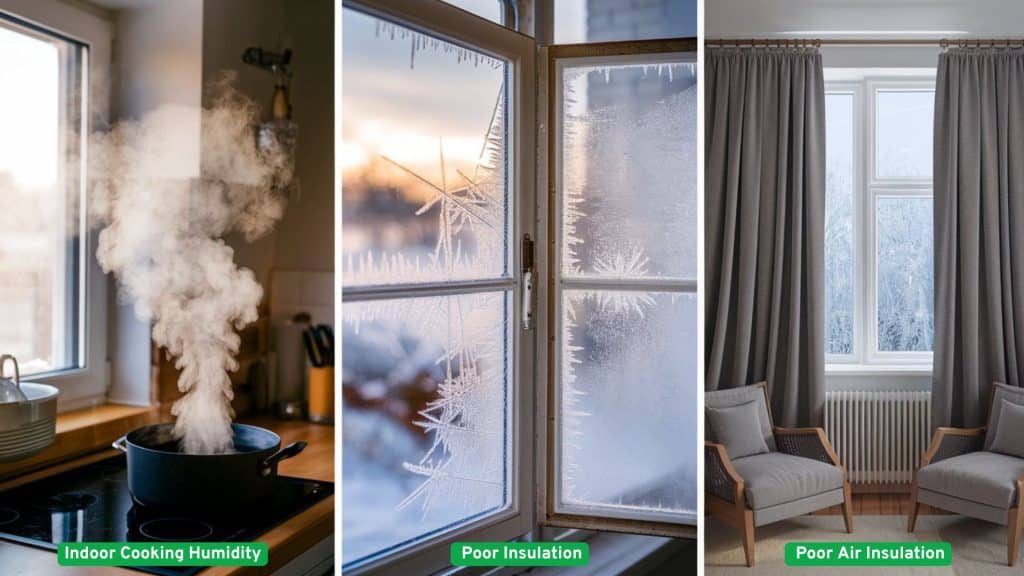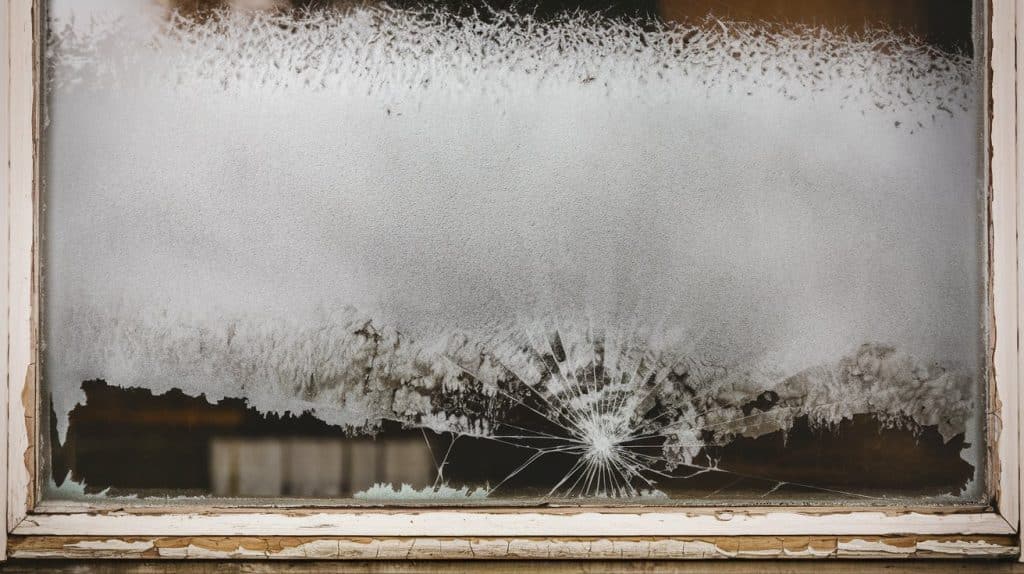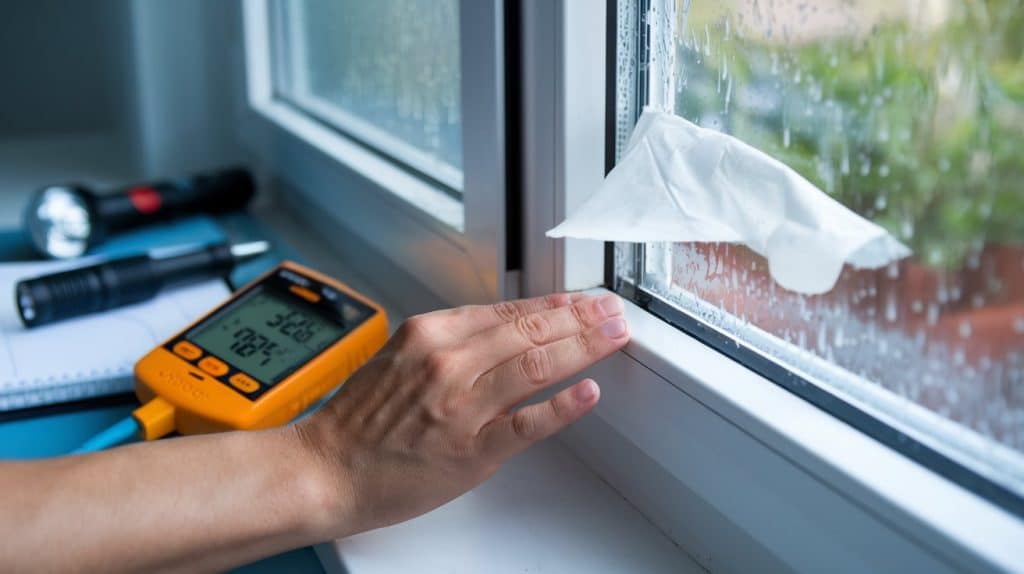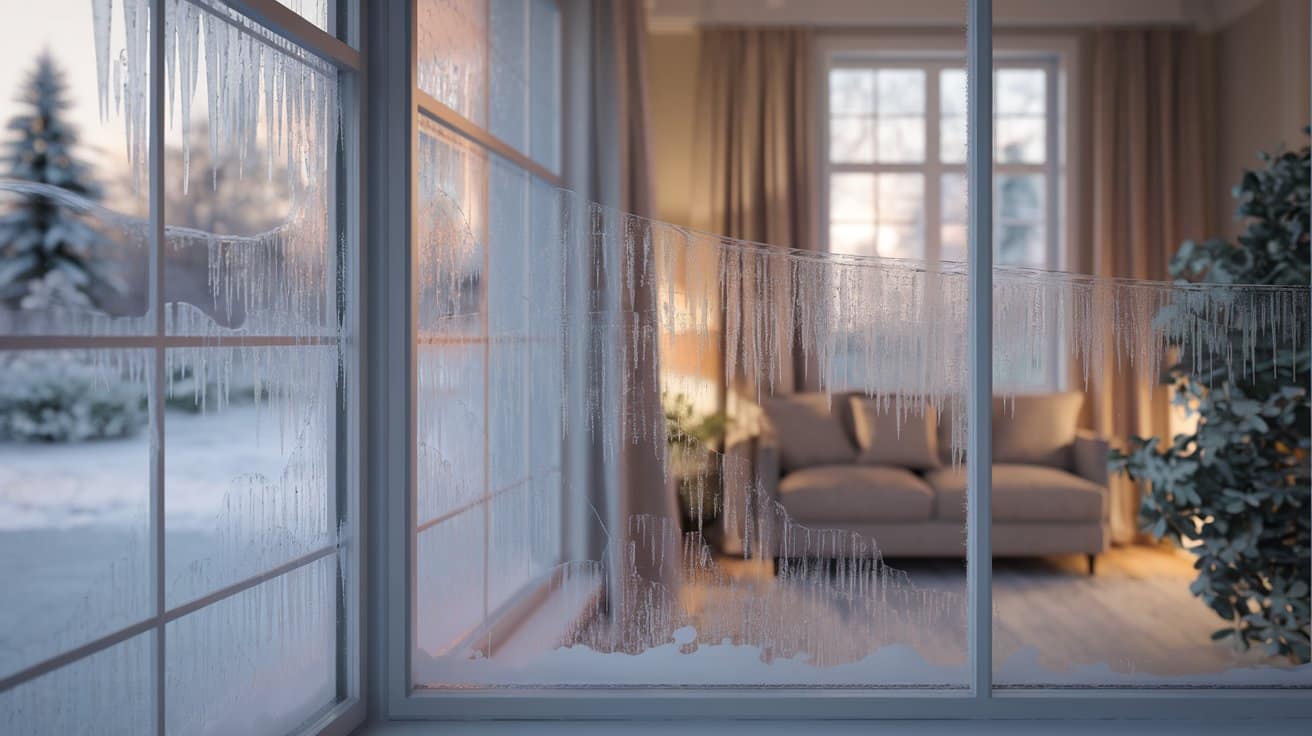Ever notice ice forming on the inside of your windows during winter? It’s more common than you think.
You might think it’s just part of winter life. But ice on your windows means that too much moisture is trapped inside your home.
This extra moisture can cause real problems, such as mold on your walls and higher heating bills. Over time, it can even damage your house.
But here’s the thing – you can fix this problem pretty easily. Most solutions are straightforward and won’t require a significant investment of money. Some fixes work immediately, while others prevent ice from returning.
Ready to learn why this happens and how to stop it? Let’s break it down.
How Does Ice Form on the Inside of Windows?
Ice forms on your windows when warm, moist air inside your home hits the cold glass surface. Think of it like your breath fogging up a mirror, but much colder.
Here’s what happens step by step:
- Warm air holds more moisture than cold air
- This warm air touches your freezing window and cools down fast
- The humidity in the air turns into water droplets first
- If the glass is cold enough, these droplets freeze into ice crystals
Your windows are the coldest surfaces in your home during winter. They act like magnets for moisture. The bigger the temperature difference between inside and outside, the more ice you’ll see.
Single-pane windows are more likely to get icy than double-pane ones. Old windows with poor seals are more prone to this problem. The process happens overnight when temperatures drop the most.
Science Behind Condensation and Frost
The science behind window ice is relatively simple once you understand the concepts of humidity and temperature.
What Is Humidity?
It’s the amount of water vapor floating in your air. Warm air can hold way more water than cold air. When warm air is cooled quickly, it must release the extra water somewhere.
The dew point matters most: This is the exact temperature at which air can no longer hold its moisture. When your window glass hits this temperature, water appears on the surface.
Why Ice Instead of Just Water?
When your window temperature drops below 32°F (0°C), the water droplets skip the liquid stage and turn straight into ice crystals.
Your home’s humidity level plays a big role:
- 30-40% humidity = rarely see ice
- 50-60% humidity = ice forms easier
- Above 60% humidity = ice forms fast and thick
The temperature difference between the inside and outside air exacerbates the issue. A 40-degree difference almost guarantees ice formation.
Common Causes of Ice Formation

Several factors in your home create the perfect conditions for window ice. Let’s examine the primary culprits.
1. High Indoor Humidity Levels: Excessive moisture in the air is the primary cause. Activities like cooking, showering, and even breathing add water vapor to your home. Poor ventilation traps this moisture inside instead of letting it escape.
2. Poor Window Insulation: Single-pane windows and old frames let cold air seep through. This makes the glass surface much colder, creating the perfect spot for ice to form. Cracked seals around windows exacerbate the problem.
3. Inadequate Air Circulation: Rooms with poor airflow trap humid air near windows. Heavy curtains, furniture blocking vents, and closed doors prevent air from moving around. This lets moisture build up in one spot.
4. Heating System Issues: Uneven heating creates temperature differences throughout your home. Some rooms become too hot, while others remain cold. This imbalance causes warm, moist air to be drawn toward cold windows.
Risks and Damages from Ice Buildup

Ice on windows isn’t just annoying – it can cause real damage to your home and health.
1. Structural Damage to Windows
Ice puts pressure on your window frames and seals. As it melts and refreezes, it expands and contracts. This cycle can crack glass, warp frames, and damage weatherstripping. Over time, you’ll need expensive window repairs or replacements.
2. Mold and Mildew Growth
The moisture that causes ice creates perfect conditions for mold. When ice melts, water runs down walls and pools on windowsills. This dampness spreads to nearby surfaces, resulting in black spots and musty odors in your home.
3. Higher Energy Bills
Ice means your heating system works harder to maintain the temperature. Poor insulation from icy windows lets warm air escape and cold air enter. Your furnace runs longer and more often, driving up monthly energy costs.
4. Health Problems
Excess moisture and mold can trigger allergies, asthma, and respiratory issues. Poor air quality from trapped humidity exacerbates these problems, especially for children and elderly family members.
How to Diagnose the Source of The Problem?

Finding the root cause helps you pick the right fix. Here are the main areas to check in your home.
- Checking for drafts and air leaks around windows – Feel around window frames with your hand to find cold spots. Look for gaps where outside air sneaks in. Use a candle or tissue to see if air moves near the glass.
- Measuring indoor humidity levels – Buy a simple humidity meter from any hardware store. Test different rooms in your house. Normal winter levels should be between 30% and 40%. Readings above 50% indicate excessive moisture.
- Inspecting window seals and frame condition – Look closely at the rubber seals around your windows. Check for cracks, gaps, or places where the seal pulls away. Notice if you have old single-pane windows that get extra cold.
- Identifying moisture sources in your home – Check if bathroom fans work when you turn them on. Ensure your dryer vents are completely outside. Count houseplants and fish tanks that add water to the air.
- Testing air circulation patterns – Hold tissue near problem windows to see if air moves. Check if furniture blocks the heating vents. Notice if some rooms feel stuffier than others.
5 Ways to Reduce Ice Formation
Here are proven methods to stop ice from forming on your windows. These solutions work for most homes and are relatively inexpensive.
1. Lower Your Indoor Humidity Levels
Use exhaust fans in bathrooms and kitchens when cooking or showering to improve air quality. Run a dehumidifier in rooms with high moisture. Maintain humidity levels between 30-40% during the winter months.
Use exhaust fans properly – Turn them on during and after showers to remove steam from the air.
2. Improve Window Insulation
Add weatherstripping around window frames to seal gaps and improve insulation. Install storm windows or plastic film kits over single-pane glass. Replace old windows with double-pane versions if your budget allows.
Apply window film – Plastic film kits add an extra layer of insulation over single-pane glass.
3. Increase Air Circulation Near Windows
Move furniture away from windows to allow air to flow freely. Keep curtains and blinds open during the day. Use ceiling fans on low speed to keep air moving around the room.
Move furniture back – Keep sofas and chairs at least 6 inches away from problem windows.
4. Control Moisture Sources
Repair leaky pipes and faucets that contribute to increased humidity in your home. Vent your dryer directly outside, not into the house. Reduce the number of houseplants in rooms with ice problems.
Fix water leaks fast – Any dripping water adds extra moisture that leads to ice formation.
5. Adjust Your Heating System
Make sure vents near windows aren’t blocked by furniture. Set your thermostat to maintain steady temperatures. Open doors between rooms to help warm air spread evenly throughout your home.
Clear heating vents – Remove rugs, furniture, or anything blocking air from reaching windows.
Temporary Quick Fixes vs. Long-Term Solutions
Some solutions work immediately, while others prevent ice from forming again. Here’s how to distinguish between them and when to use each approach.
| Quick Fixes (Work Right Away) | Long-Term Solutions (Prevent Future Problems) |
|---|---|
| Use a hair dryer to melt ice off windows in minutes | Replace old windows with double-pane versions to stop ice from forming |
| Wipe windows dry to remove moisture before it freezes | Add proper insulation by sealing gaps around frames permanently |
| Turn up the heat temporarily to warm glass surfaces | Install ventilation fans to remove moisture at the source |
| Open the curtains wide to let warm air reach the glass | Upgrade weatherstripping to create seals that last for years |
| Move a space heater toward the problem windows for quick warming | Fix humidity issues with a whole-house dehumidifier system |
| Crack windows slightly to let cold air mix with warm air | Improve home airflow by upgrading your HVAC circulation system |
When to use quick fixes: During cold snaps, emergencies, or when you’re renting and can’t make permanent changes.
When to invest in long-term solutions: If ice forms every winter, you own your home, or quick fixes are no longer effective.
Myths and Mistakes to Avoid
Many homeowners try the wrong solutions for window ice. Here are common mistakes that exacerbate the problem instead of resolving it.
1. Opening Windows in Winter
Some people believe that opening windows allows moisture to escape. This brings in more cold air, which makes ice form faster. Opening windows also wastes energy and drives up heating bills. The cold air hits your warm windows, creating even more condensation.
2. Using Salt on Interior Windows
Salt works on outdoor ice but damages indoor surfaces. It can stain window frames, corrode metal parts, and leave white residue on glass. Salt also attracts more moisture from the air, making your humidity problem worse over time.
3. Cranking Up the Heat Too High
Turning your thermostat way up doesn’t solve the root problem. High heat creates more humidity in your home as people breathe and do daily activities. This extra moisture exacerbates ice formation when it hits cold windows.
4. Ignoring the Problem Completely
Some homeowners think window ice is normal and harmless. Ignoring it leads to mold growth, damaged walls, and higher energy costs. The moisture that causes ice can rot window frames and create serious structural problems.
5. Using Fans to Blow Air Directly at Windows
Pointing fans right at icy windows seems logical, but often backfires. Cold air from outside makes the glass even colder. Instead, use fans to improve overall air circulation throughout the room.
Conclusion
Window ice forms when warm, humid air comes into contact with cold glass surfaces. The primary causes include high indoor humidity, inadequate window insulation, and restricted air circulation.
You can fix this with simple steps—lower humidity by using exhaust fans and dehumidifiers. Improve window insulation with weatherstripping or plastic film. Move furniture away from windows to improve air flow.
Avoid common myths like opening windows in winter or using salt on glass. These mistakes make the problem worse and waste your money.
Most solutions are inexpensive and effective. Start with the easiest fixes first, then proceed to larger improvements if necessary. Your windows will stay clear, and you’ll save money on heating bills.
Frequently Asked Questions
How to Stop Window Condensation Overnight?
Keep curtains open at night to maintain a more consistent room temperature. Closed curtains make glass colder, causing more condensation to form on the surface.
Does Vinegar Prevent Ice?
Yes, vinegar works as a natural deicer. Mix three parts vinegar with one part water in a spray bottle to prevent ice formation on windows.
What Melts Ice the Fastest?
Salt melts ice faster than sugar, baking soda, or hot water. It lowers the freezing point of water by breaking up hydrogen bonds in the ice crystals.


